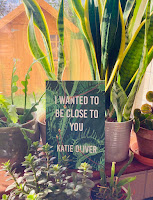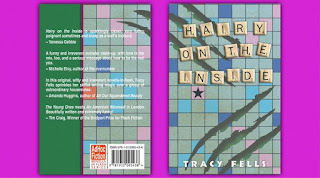I am excited to welcome writer Katie Oliver onto the Blog to talk about her fabulous debut short story collection I WANTED TO BE CLOSE TO YOU (published by Fly On The Wall Press).
My review of Katie’s collection can be found at the end of the interview below.
About Katie Oliver:
Katie Oliver is a writer based on the west coast of Ireland. Her debut short story collection, I WANTED TO BE CLOSE TO YOU, is available to order from Fly on the Wall Press, and she is a first reader for Tiny Molecules. She can be found on Twitter and Instagram @katie_rose_o
"I wanted to be close to you. So I went to the forest..."
Gardens, relationships and imaginations run wild in Katie Oliver's debut short fiction collection. The world is unpredictable and no woman is safe. Boundaries are blurred: between fantasy and reality, technology and nature,
autonomy and oppression. The threat of violence simmers throughout as women transform into birds, converse with plants and plot their revenge. These dark, surreal tales will put down roots and stay with you long after reading: how close... is too close?
Q. I loved everything about this collection and at times it felt as if I was looking inside my own head ... I'm intrigued to know what triggers a story idea for you, can you share the back stories to writing some of these pieces?
Thank you! And I don’t know whether to celebrate or commiserate with you as the owner of a similar sort of brain… Anyway, I’m so happy you asked this as it’s something I love talking about. My stories often come from something I’ve physically come across. For example, ‘Spider Season’ was inspired by a ton of webs appearing in my kitchen, and ‘Gum Leaf Skeletoniser came about after I read this article. Similarly, I wrote ‘Puff’ after reading this review of a sleep robot. There’s a Susan Sontag quote about a writer being someone who looks at the world and I wholeheartedly agree with this. I don’t really ever struggle for ideas because I feel like they’re always there, smacking me round the chops when I least expect it. The notes app on my phone is a disaster, as you might imagine.
Then there are the strange stories that seem to arrive into my head fully formed, or else appear to me when I’m in sort of a fugue state in the shower. That sounds silly, but I really do get some of my favourite ideas while I’m under running water. ‘All That Glitters’ was one of those; I’ve racked my brains and have no sense of how I actually came to formulate the idea or the protagonist.
Q. How long have you been writing? Can you tell us about the journey to finding a home for this collection?
I’ve always enjoyed writing but took a fairly meandering path to where I currently am. As a child I wrote a lot for fun, but as a teenager this quickly shifted into intensive reading. Then as an adult, while working in a nursery I developed a love for children’s fiction. I had several unsuccessful forays into writing/pitching various picture books (RIP Fed Up Fred the disgruntled snail), and then decided to do an MA in Children’s Literature when my son was four months old (I know, I am a masochist). Despite the obvious challenges I enjoyed it a lot and my dissertation became the first 15,000 words of a novel I wrote for young adults, which I queried but got nowhere with. Meanwhile, I entered my university’s annual creative writing competition on a whim - it was fiction for adults and I wrote ‘TimeOut’ as a result of being very sleep deprived. To my shock it won! That experience was totally pivotal for me as I realised that maybe I could write for adults, and should really knuckle down to it. One of the tutors suggested I start submitting my work to journals, and I am nothing if not obedient, so I did. Fast forward three years and I had a few publications and enough writing for a collection. Fly On The Wall was actually only the third publisher I sent the collection to, which I’m aware makes me sound jammy, but I think it was a really lucky case of finding someone like Isabelle who really got what I wanted to do with it. I feel so fortunate to have her on board!
Q. Are there themes/topics that you want to explore further or highlight with your writing?
More of the same! I absolutely love writing about weird stuff from the natural world, body horror, new technologies, etc. However, I’m also working on expanding my repertoire a bit, through the prism of the themes I already write about. I’d like to try a few ghost stories, and to write a bit more about characters actually rooted in reality (terrifying).
Q. One of my favourite characters from the collection is Lara in 'The Sanctuary', whose secret talent is talking to plants. Do you have any favourites amongst the characters you've created? And if you had a secret ability what would it be?
Cecilia from ‘All That Glitters’, hands down. I don’t know why, I just like her, and really sympathise with her. She just wants to be loved! My dream secret ability would have to be either teleporting or magicking dinner being ready.
Q. If you suddenly had a bonus day off to do whatever you wanted, what would you do?
This sounds so boring, but it would honestly be going for a run in the morning, and then going for a nap in the afternoon - two favourite activities I don’t have enough time for!
[I think this sounds a perfect day off, the run for me definitely and LitPig never turns down the opportunity to nap!]
Q. Can we look forward to more work from you? Any projects in the pipeline that you're happy to share?
Yes! I’m currently well into writing my next short story collection - it’s all short stories rather than flash and I’m genuinely excited about it. I’m also currently pitching a novel for adults, sloshing about in the tragic barrel of tears that is querying. I have one full request out but I know that doesn’t really mean anything. I’m not giving up on it yet! And I’ve got about 5000 words of a new novel which I’ll crack on with if this one comes to nothing. I’d have honestly been horrified if you’d have told the 23-year-old me that I might have to write multiple novels before getting an agent but now I accept it as part of the process. Also, I do absolutely love the writing of them, despite having to wildly shoehorn time in around work and domestic life, so it’s something I’d do regardless of any nebulous promise of ‘success’.
Q. Importantly where can readers buy a copy of I Wanted to be Close to You?
I will start by saying, if you have bought a copy, or are thinking of buying one, then thank you, thank you, thank you! I can’t quite underline enough how much it makes my day when I hear someone got my book, and even better, enjoyed it. I obviously coerced lots of my friends and family into buying it but it’s absolutely wild to me that people I’ve never interacted with before are engaging with it.
The best place to get it from is direct from Fly On The Wall Press, here. It’s also available both online and quite widely in store from Waterstones, Foyles and online at Blackwells. There are also some lovely indies stocking it and they are: Five Leaves in Nottingham, Bookhaus in Bristol, The Winding Stair in Dublin and Vibes and Scribes in Cork. And there is of course the option of asking your local library to order it in.
I will finish by saying thank you so much for asking me to be part of your blog, and that I’m really looking forward to getting my hands on your book, ‘The Naming of Moths’ - also out with Fly On The Wall later this year! [Thank you, Katie!]
My review of I Wanted To Be Close To You:
This is a marvelous debut short story collection from Katie Oliver showcasing her talent for exploring all things weird and wonderful. These stories are surprising, incredibly imaginative and often very moving. I cheered on the woman who listens to plants, and took a closer look at my own office plants after reading. Magical realism sits alongside speculative fiction, and at times I it felt like I was looking inside my own head (I think this is a good thing!). If you like your short fiction surreal yet still rooted in our challenged reality then I highly recommend ‘I wanted to be close to you’.
















